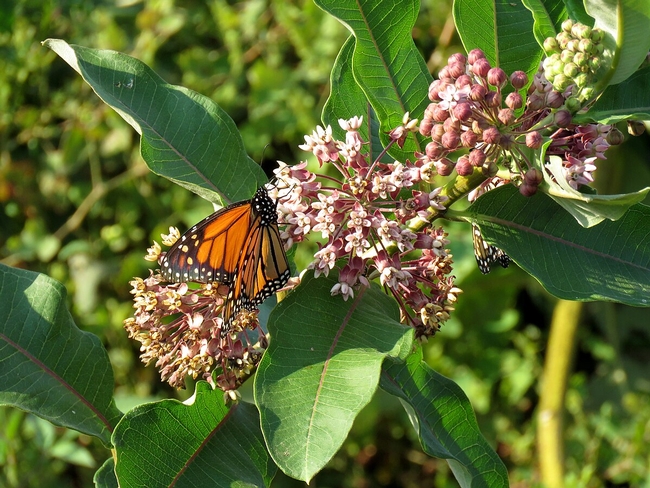“Well, I must endure the presence of a few caterpillars if I wish to become acquainted with the butterflies.” ? Antoine de Saint-Exupéry, The Little Prince
Monarch butterflies are more than beautiful; they contribute to the health of our planet by feeding on nectar and pollinating many types of wildflowers. They are also part of nature's food chain as an important source of food for birds, small animals and other insects. Monarchs are considered an ‘indicator species,' which means it's the canary in the coal mine. Its sensitivity to climate change, harmful chemicals and habitat destruction send a signal to address these conditions before there is more damage to the environment.
Due to the decline of monarch butterflies and their shrinking migratory paths in the United States, home gardeners are being encouraged to plant milkweed. Why milkweed? Monarchs cannot survive without milkweed. The females only lay their eggs on milkweed as they migrate. To grow and develop, the monarch caterpillars need milkweed plants.
Before you run to the nearest garden shop, nursery or box store garden center to help the plight of the monarch, there is something you should consider. There are many, many milkweeds on the market, some native and some tropical. The Monarch Joint Venture, Xerces Society and the U.S. Fish and Wildlife Service, all of which are dedicated to saving monarchs, all recommend only planting milkweed varieties that are native to your location.
Native milkweed in California typically flowers between late spring and the end of summer. Following seed dispersal, the above-ground portion of the plant dies back to the ground remaining dormant through the winter. In spring it re-emerges from the established root system.
Many of the varieties being sold are tropical milkweeds, which are not native to the U.S. and have foliage year-round when it grows where winters are mild and adequate moisture is available (in this circumstance, Fresno is considered mild). Research suggests that the tropical milkweed may encourage monarchs to lay eggs outside of their regular breeding season, disrupting their migratory cycle, and increasing the prevalence of monarch infection by the protozoan parasite Ophryocystis elektroscirrha, aka “OE.” If you have already planted a tropical milkweed in your garden, it is suggested that you cut it to the ground in fall when natives would be dying back. It should re-emerge in the spring. This would prevent the female from laying eggs at the wrong time in their migration.
The following California species should be your first choices when planting milkweed in Fresno, Clovis and surrounding areas:
- Butterflyweed (Asclepias tuberosa) – sometimes called Orange Milkweed. Large flat-topped clusters of yellow-orange or bright-orange flowers. Blooms May to September. Needs sunlight. Drought tolerant, dry or moist soil. 1-2 ft. tall.
- Antelope-horns Milkweed (Asclepias asperula) – Also known as Spider Milkweed. Pale greenish-yellow flowers, tinged with maroon. Blooms March to October. Needs sunlight, dry or moist soil. Medium water use. 1-2 ft. tall.
- Showy Milkweed (Asclepias speciosa) – Blooms May to September. Blue-green leaves and spherical clusters of rose-colored flowers. Shade tolerant, needs some sunlight. Medium water use. Moist soil. 1 ½-3 ft. tall but can reach 6 ft. under favorable conditions.
- California Milkweed (Asclepias californica) – Native to Central and Southern California. White-wooly plant and deep purple flowers. Blooms May to July. Drought tolerant, dry slopes. Maximum height 3 ft.
- Mexican Whorled Milkweed (Asclepias fascicularis) – aka Narrowleaf milkweed. Clusters of greenish-white flowers often tinged with purple. Blooms June to September. Needs sunlight. Drought tolerant. Dry to moist soil. 1-2 ½ ft. tall.
- Desert Milkweed (Asclepias erosa) – White to yellow flowers. Green to yellow stems. Blooms April to October. Best grown in desert conditions of sandy soil. Needs sunlight, dry soils. Not shade tolerant. 1-3 ft. tall.
Although milkweed does contain toxins, it is not usually a significant threat to animals or humans. Milkweed has a foul taste and is not likely to be consumed by pets or children in a quantity that would prove harmful. Still it is best to prevent accidental ingestion by teaching children to avoid contact with the plant and to wash their hands if they do touch it. If animal or human poisoning is suspected, call the poison control center or seek medical help.
For more information on milkweed and monarchs go to the following websites:
- Milkweed for Monarchs
- Native Milkweed by State
- Milkweed FAQ
- Monarch joint venture chart
- Journey North Tracking Migrations
- Pollinators – Monarch Butterfly
Originally written November 2019. Updated May 2024.
